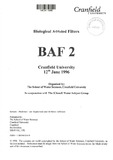JavaScript is disabled for your browser. Some features of this site may not work without it.
| dc.contributor.author | Cantwell, A. D. C. | |
| dc.date.accessioned | 2017-03-03T11:26:07Z | |
| dc.date.available | 2017-03-03T11:26:07Z | |
| dc.date.issued | 1996-06-12 | |
| dc.identifier.citation | A.D.C. Cantwell. Operating performance and future development of the BioBead (TM) system. 2nd Symposium on Biological Aerated Filters (BAF2) - 12 June 1996, Cranfield University, Cranfield, UK | en_UK |
| dc.identifier.isbn | 1861940149 | |
| dc.identifier.uri | http://dspace.lib.cranfield.ac.uk/handle/1826/11553 | |
| dc.description.abstract | This paper reports on the performance of the BiobeadTM version of the Biological Aerated Flooded Filter Process over the last few years. More than twenty of these units have been installed in the U.K. and the operating experience has enabled further development steps to be made, the range of application to be widened and the design methods associated with the technology to be refined. Operating problems have arisen when the design load is less than that found upon commissioning. For the BAFF system because of the short retention times within the media bed it is essential that excess dissolved oxygen is present at all times. Diurnal peaks in load must be allowed for in design. A related problem is that of septic influent. Septicity has a profound influence on the development flora and fauna in any biological system and so it is preferable that septicity is corrected outside of the BAFF system. Similarly intermittent saline intrusion will reduce performance, although to a lesser extent than that found on Activated Sludge processes. The final problem with BAFF's is that of media quality which is exclusively a quality control problem. The major engineering change introduced to the Biobead system is the aeration system which is now a simple sparge tube immersed in the media. This increases the allowable air rates and is particularly helpful in designing for larger than normal diurnal variation. Similarly, the air scour system now used an array of simple drop tubes. The performance of the media has been further improved by the use of charge neutralising additives to the plastic formulation together with broadening the range of source materials able to produce the textured surface finish. Modules of any size can be produced by assemblies of smaller modules of proven engineering performance. | en_UK |
| dc.language.iso | en | en_UK |
| dc.publisher | School of Water Sciences, Cranfield University | en_UK |
| dc.rights | © 1996. The contents are world copyrighted by the School of Water Sciences, Cranfield University, in the first instance. Permission must be sought from the School of Water Sciences before the whole or any part of this document is transcribed. | |
| dc.title | Operating performance and future development of the BioBead (TM) system | en_UK |
| dc.type | Conference paper | en_UK |
